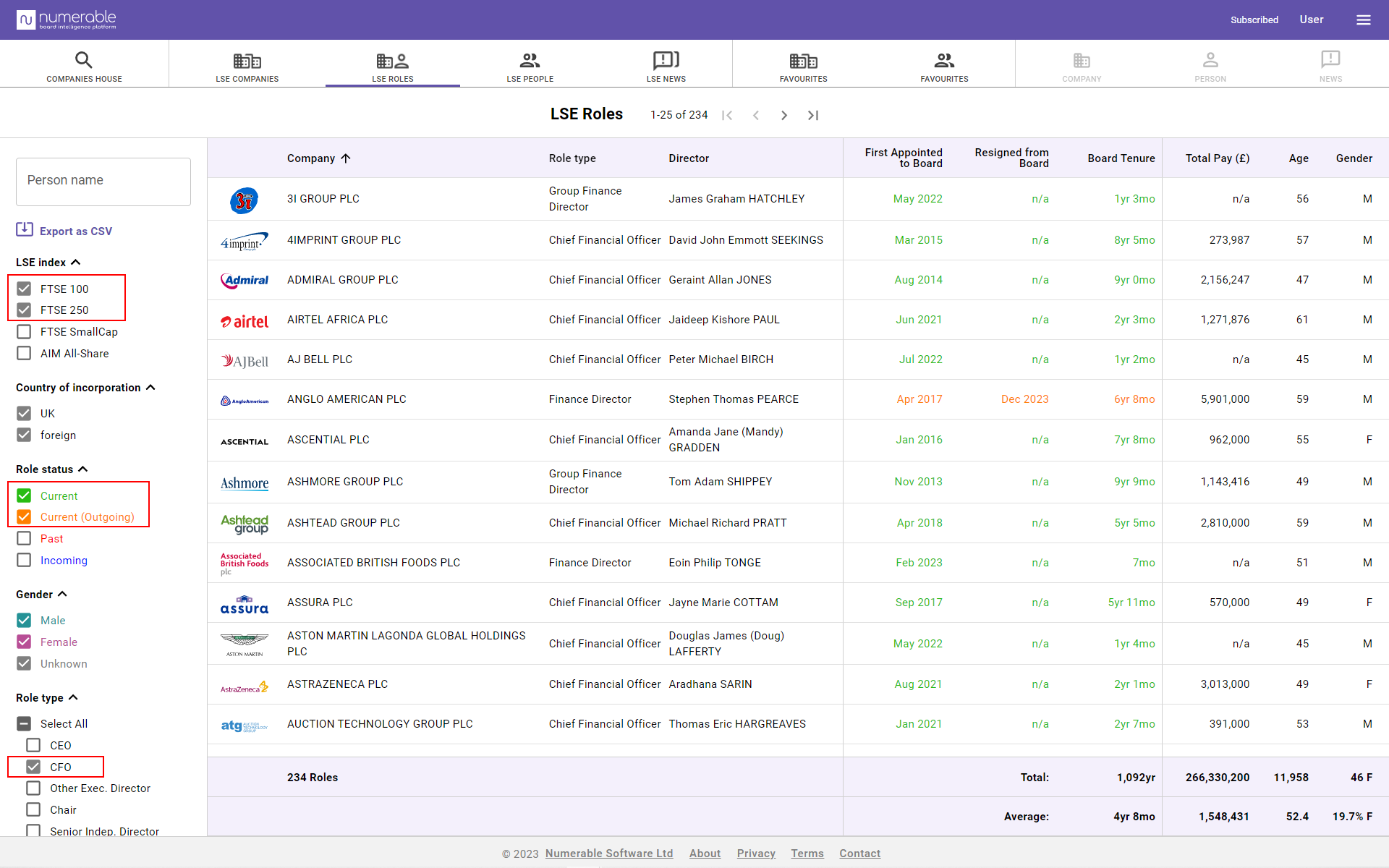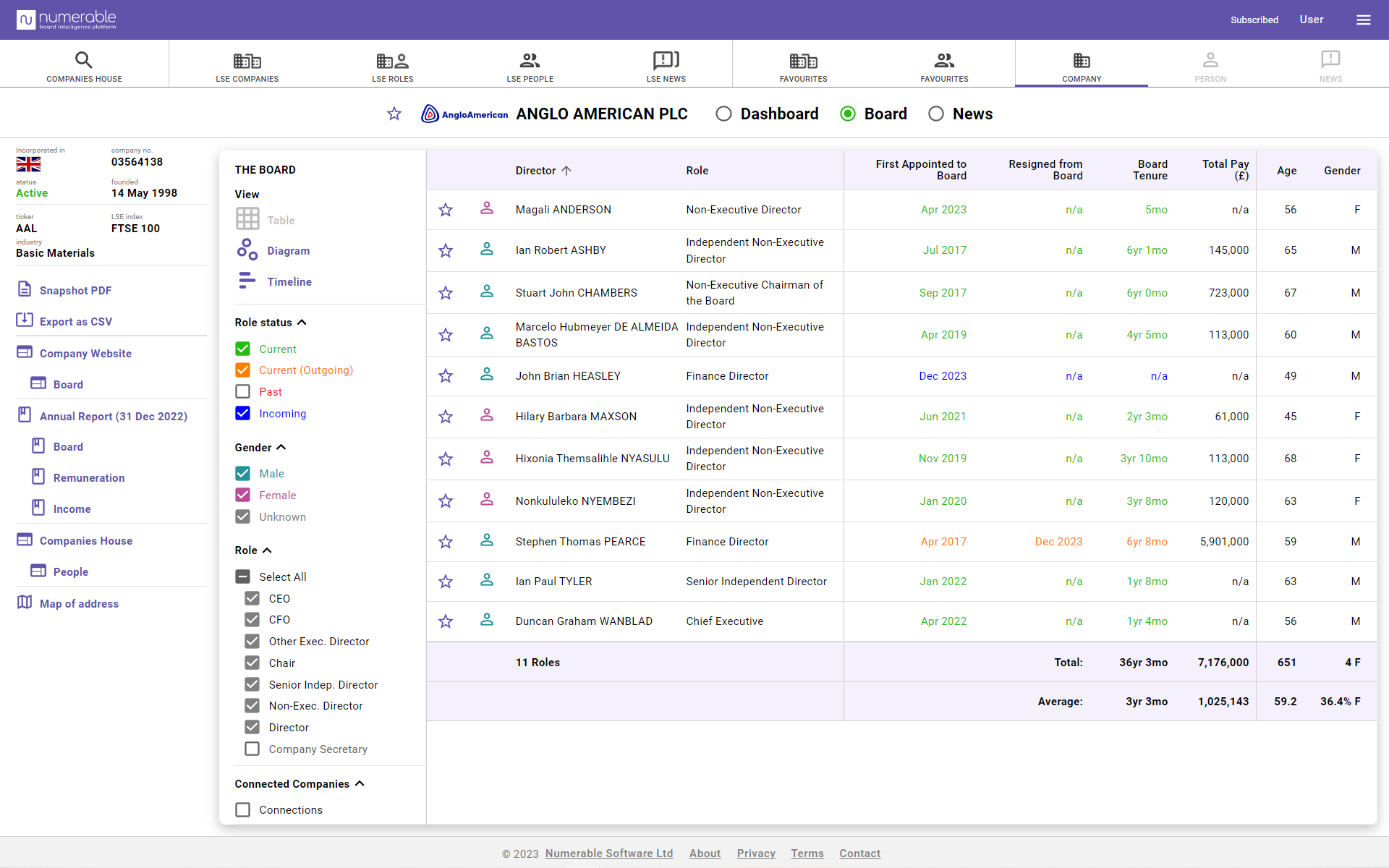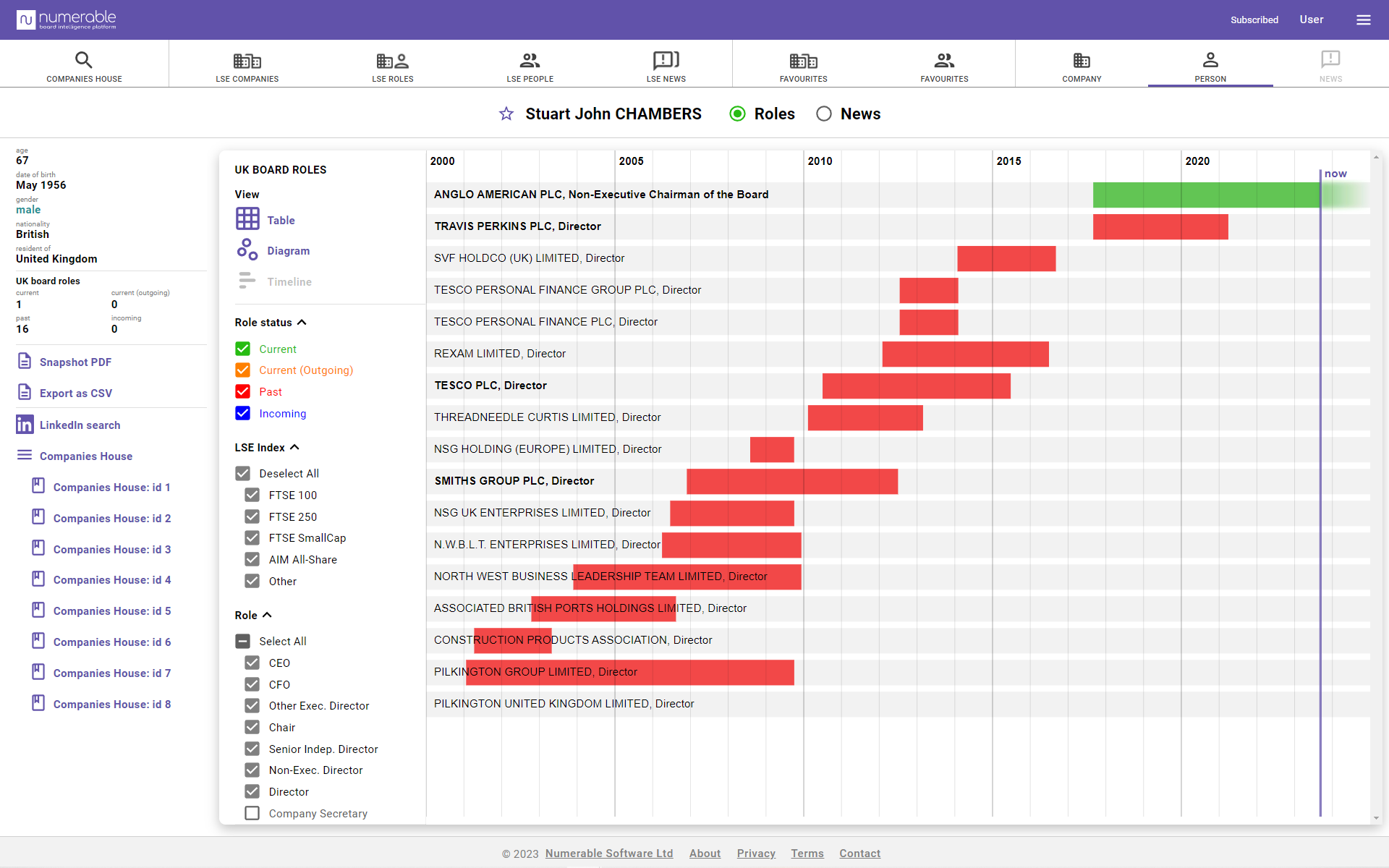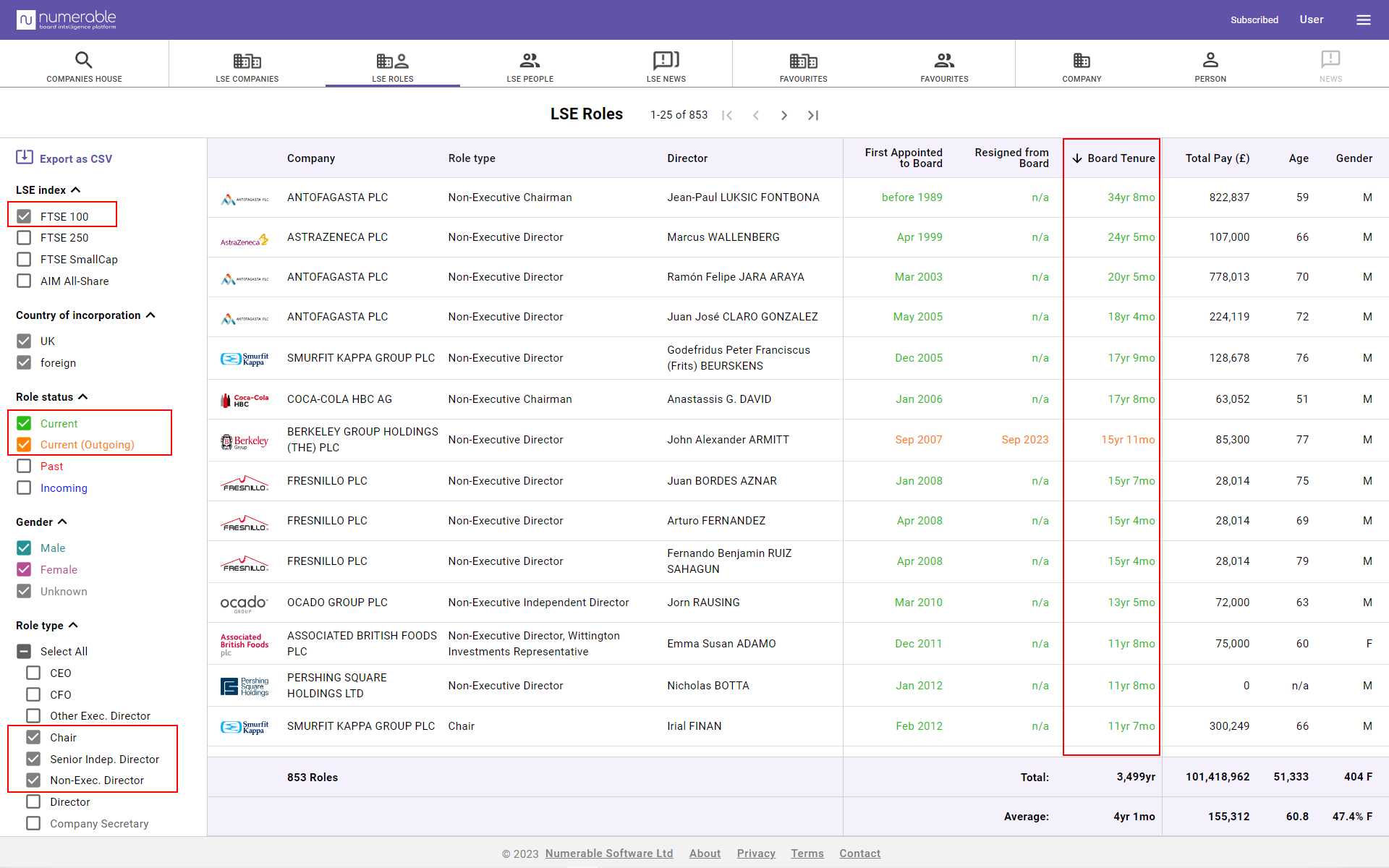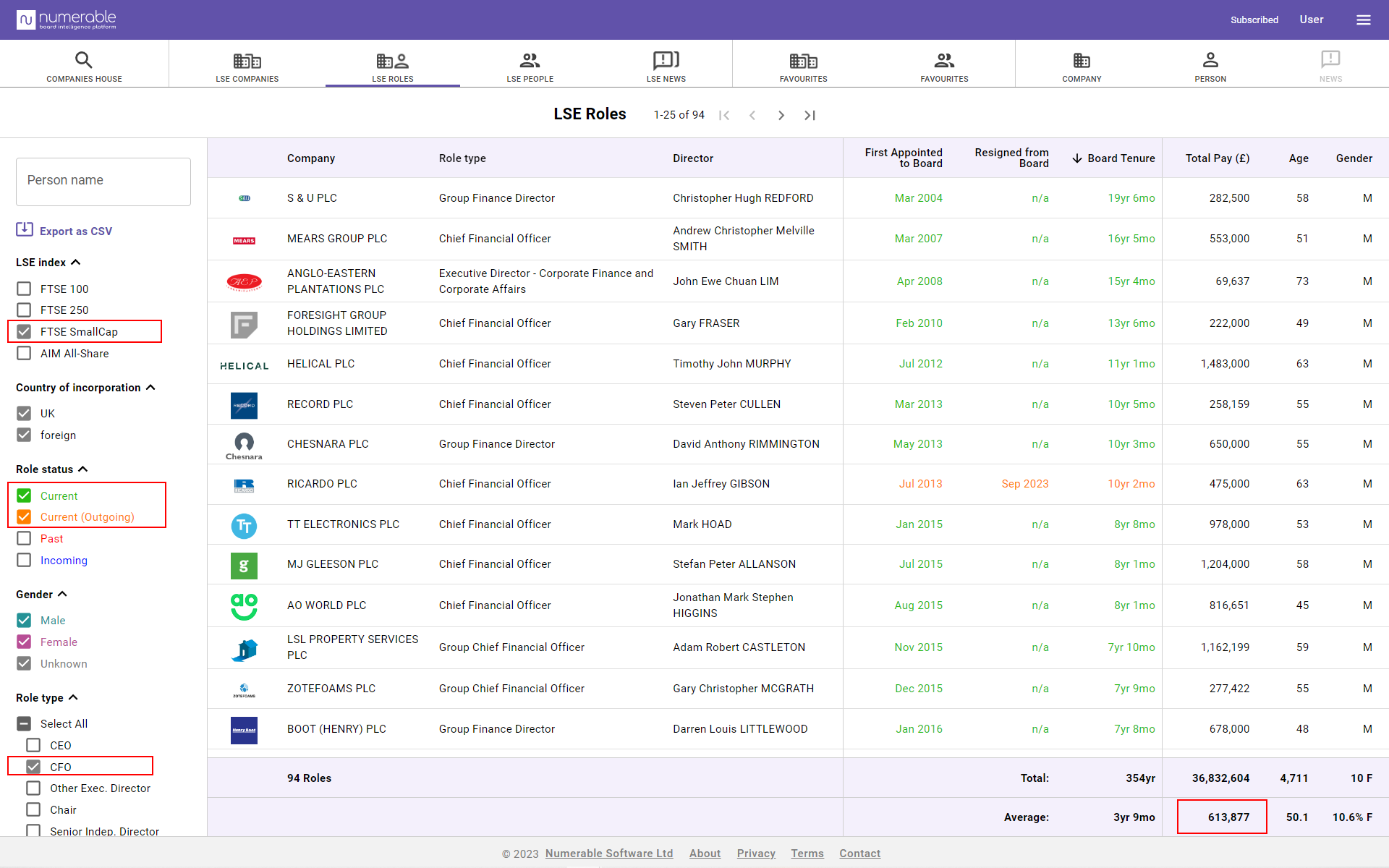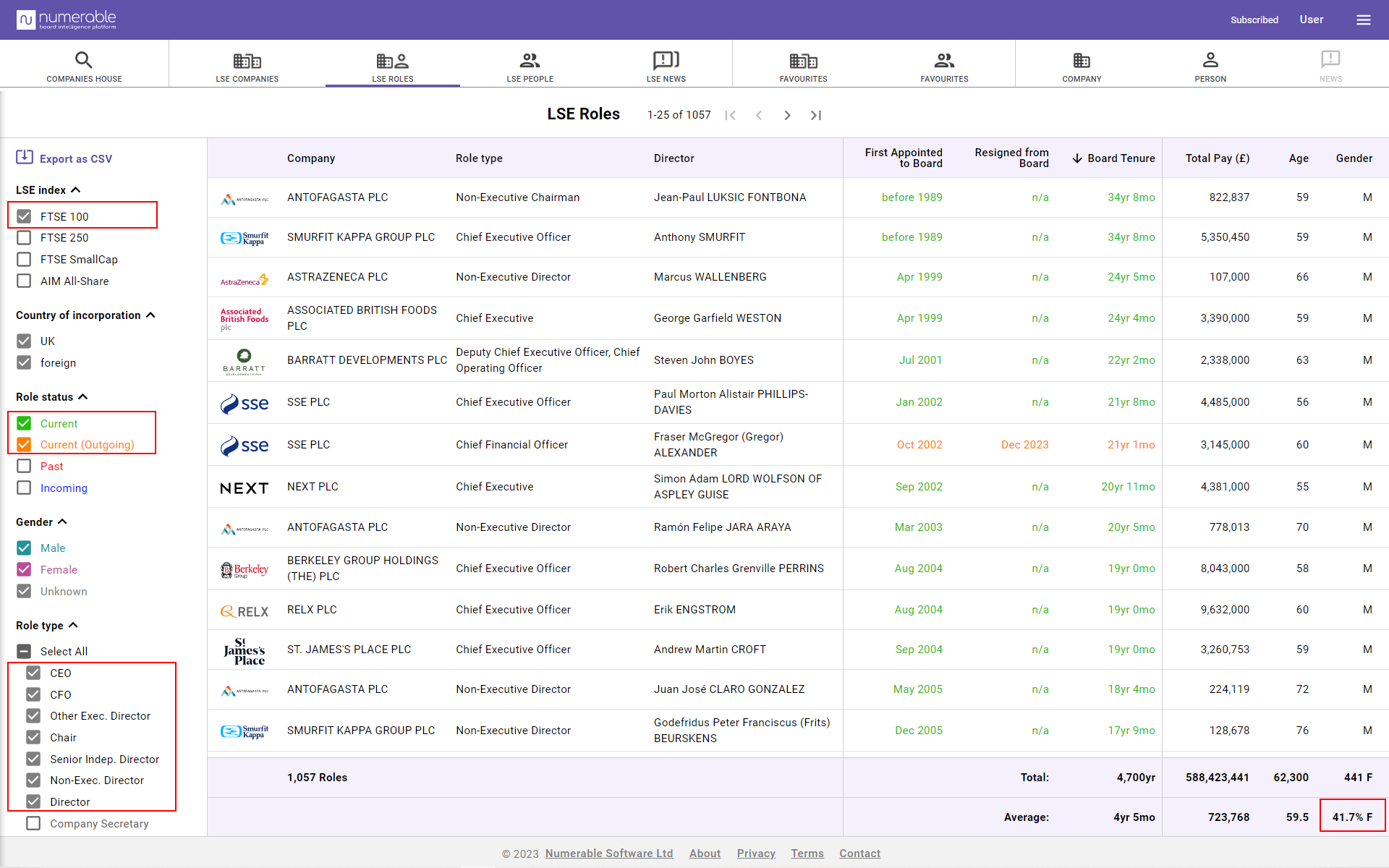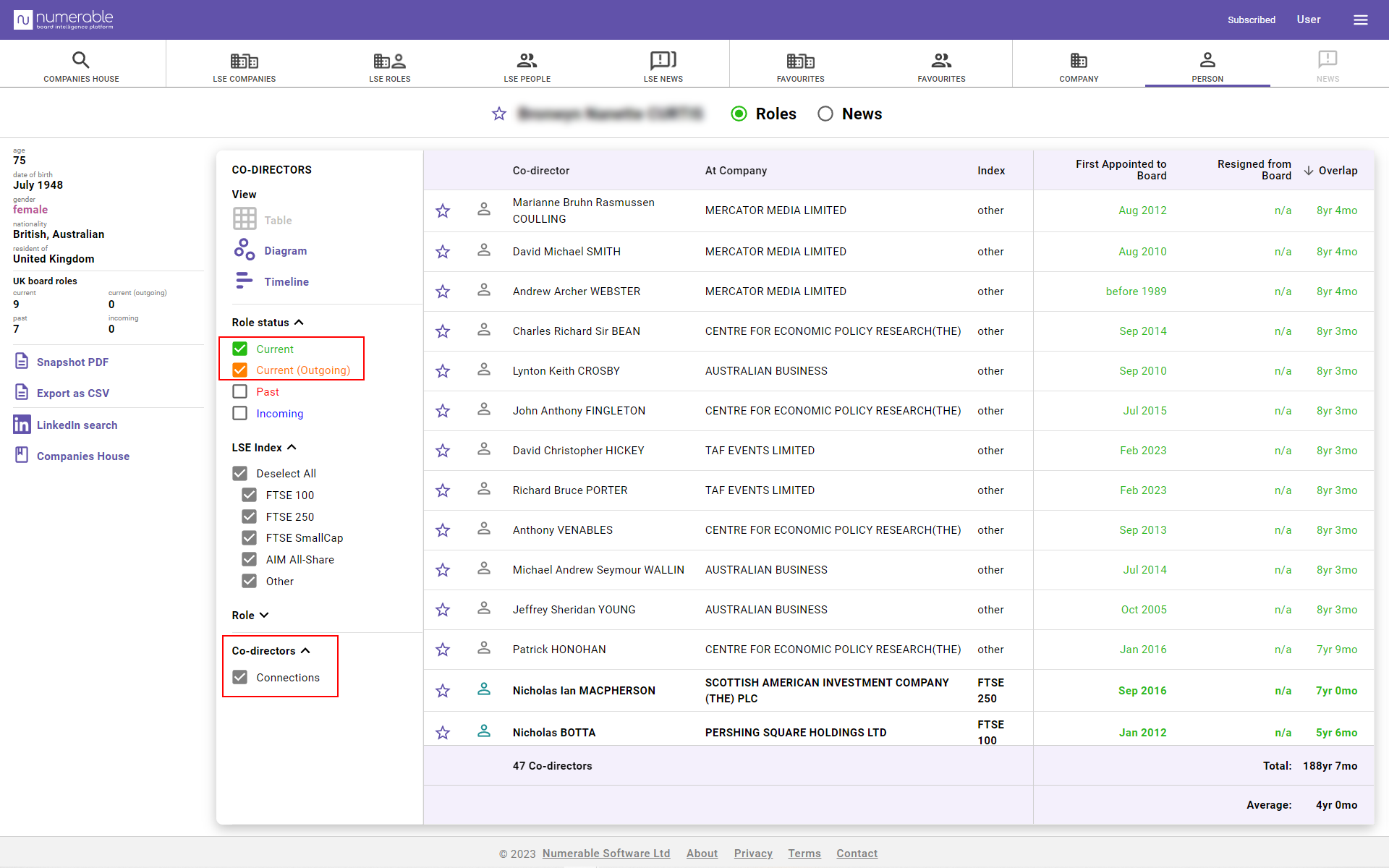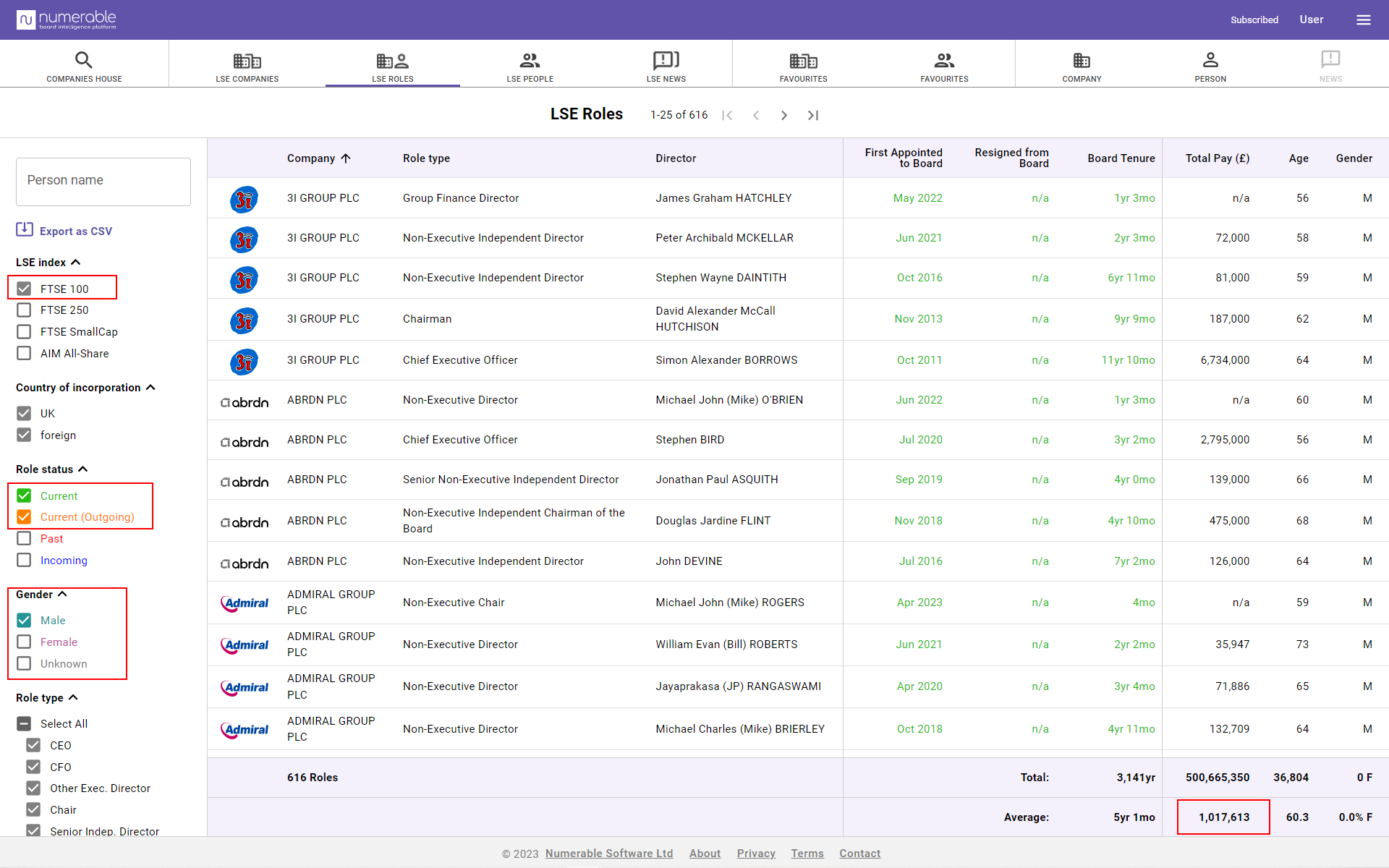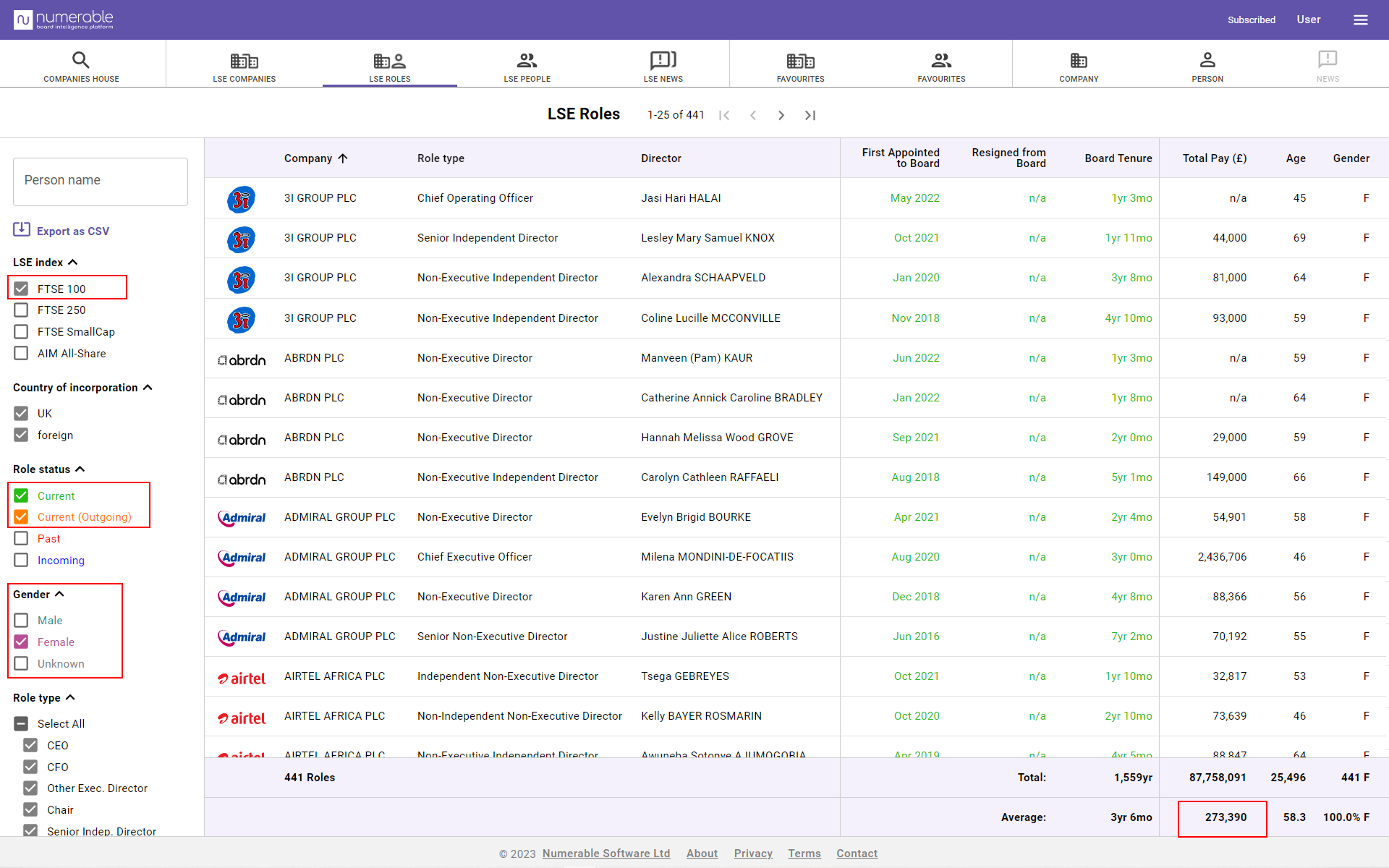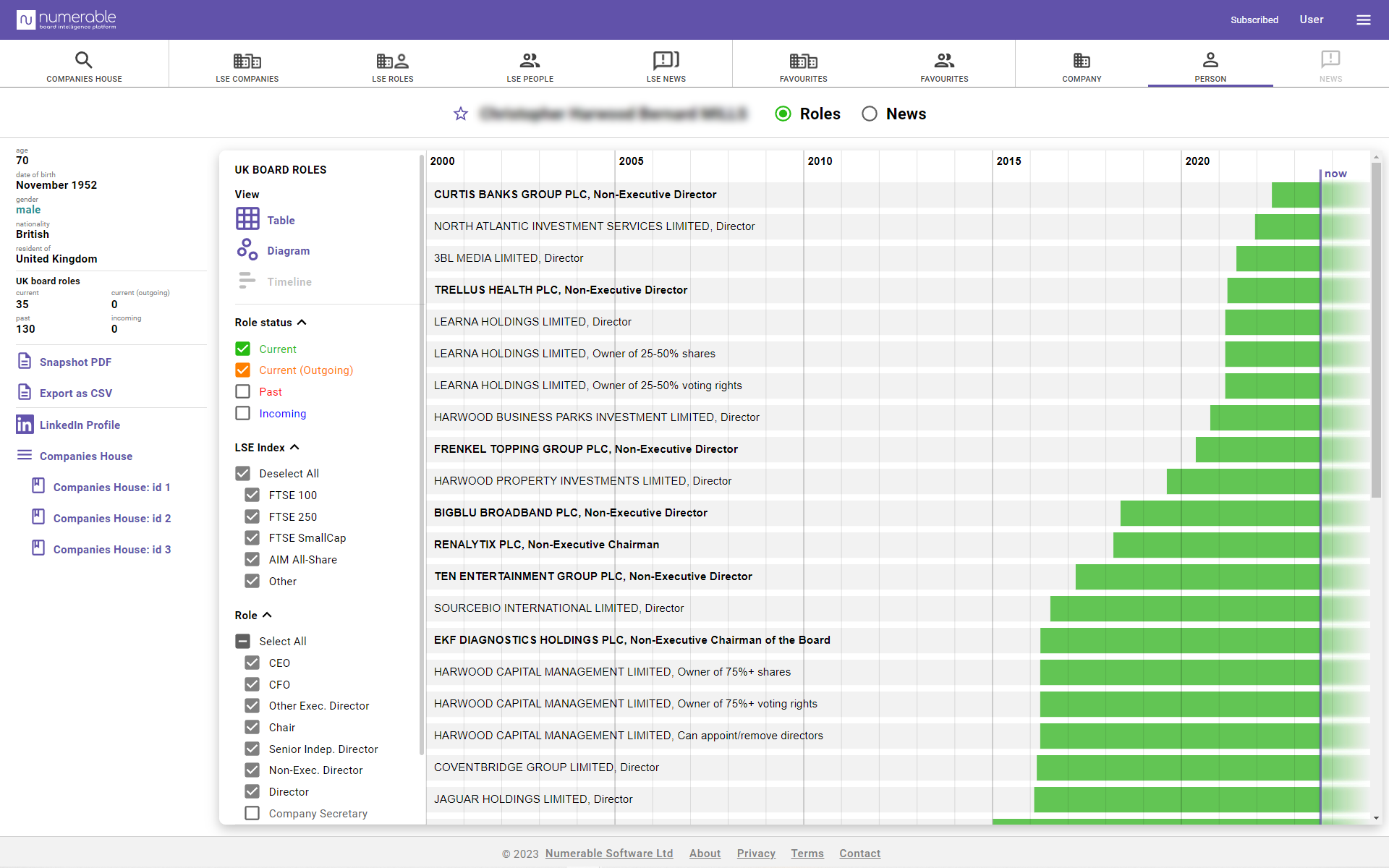Numerable can be used in a wide range of ways to save time on research and quickly answer key business questions.
…while other uses are not so obvious
Candidate long list
If you are working on a CFO search mandate you may want to add current FTSE350 CFOs to your candidate long list.
- Go to the LSE Roles page
- Select FTSE 100 and 250 indexes, and CFO from Roles filters
- Deselect Past and Incoming
The table shows 250 current CFOs with their tenure, remuneration, age and gender. You can sort them, search and add further filters as you need.
Export as CSV to download a file that you can open in Excel and other software.
Company board research
You’re interested in a company and want to learn about them and their board.
Go to their Company page by searching on the LSE Companies or Companies House page, to view.
- company details, numbers of officers
- for public companies, key metrics such as market capitalisation, revenue and employees
- a table, diagram or timeline of their board
You can:
- filter and sort the board roles
- find connected companies with whom they share a director
- export roles to CSV or download a PDF Snapshot
- click through (as relevant) to the company website, annual report, Companies House page, or a map.
Person research
You’ve found someone you’re interested in and want to learn more. Numerable can help.
First find that person. If you know they are a current or past director of a public company then search on the People page – if not, then search on the Companies House page.
Click through to their Person page to see:
- age and month of birth, nationality and country of residence
- their roles, with dates, tenure and (for public company roles) job titles and remuneration
You can:
- view their current and past public and private board roles, as a table, diagram or timeline
- filter and sort the roles to find the ones that are most relevant
- see who they know best – their co-directors
- export roles to CSV
- run a LinkedIn search (or click straight to their LinkedIn page if available).
Long tenure non-execs
The UK Corporate Governance Code recommends a maximum tenure of 9 years for independent non-executive directors.
Headhunters and advisers can use Numerable to identify long tenure non-execs who are likely to resign soon, leading to recruiting opportunities.
- Go to the LSE roles page
- Set the role filters for Chair, Senior Independent Director and Non-Executive Director
- Set other filters e.g. index and industry, to limit the scope
- Sort to show the longest tenure roles by clicking on the Board Tenure column header
79 FTSE 100 non-execs are listed with tenure longer than 9 years, and another 50 with 8 years tenure.
You can export to CSV and remove those listed who are not relevant, such as company founders.
Remuneration benchmarking
When setting or assessing the remuneration level for a board role it is useful to benchmark the same role in similar companies.
- Go to the LSE roles page
- Select the filter for the role you are interested in, e.g. Senior Independent Director
- Set other filters e.g. index, status and industry, to limit the scope
The average remuneration is shown at the bottom of the remuneration column. If the scope is current SmallCap SIDs this is £47,052.
Note that directors appointed recently do not have remuneration data as this is only published in a later Annual Report.
Board gender balance
The percentage female for an individual company is shown at the bottom of the gender column on the table view of its Company page.
But you can also find the overall percentage for a group of companies:
- Go to the LSE roles page
- Use the filters to select the group of companies you are interested in. e.g. All FTSE 100 director roles (so deselect Company Secretary)
- The percentage female of the group is shown at the bottom of the gender column. This is currently 39.5% for FTSE 100 directors.
This can be repeated for other groups.
Average percent female is 38.0% for FTSE 250, 33.5% for SmallCap – but only 15.1% for AIM All-Share directors.
Co-directors
You’ve come across a company director or secretary who is a potential candidate or client that you do not know. There is a good chance that one of your existing contacts does know them, through being a director on the same board, now or in the past.
A person’s co-directors are the core of their trusted personal network – they are people they have worked closely with, often over many years.
To generate a list of co-directors:
- Go to the LSE People page (for a public company director) or the Companies House page (for private company director) and search for the person.
- Click through to their Person page.
- Select ‘Connections’ at the bottom of the filters column.
- View then view the co-directors, as a network diagram or table.
- Sort the table by “Overlap” to see who the person has been a co-director with for longest.
You can export the list to CSV to further analyse the people in a spreadsheet or load them into your CRM.
Gender pay gap
For any group of public companies you can quickly find the gender pay gap for directors – the difference between the mean remuneration for men and women.
- Go to the LSE Roles page
- Select the filters to show the roles for the companies you’re interested in – e.g. FTSE 100, current and outgoing roles, all directors – this lists 1,057 director roles
- Select Male and deselect Female and Unknown to show just the roles held by men
- The average remuneration for men is shown at the bottom of the Single Figure Remuneration column: £1,017,613 (on 8/9/23)
- Deselect Male and select Female to find the average for women: £273,390
In this example men are paid, an average, 3.7 times than women! This is mainly because of the much higher proportion of men in the best paying executive board roles.
We discuss this here in our blog.
Overboarding or conflicting roles
Directors of public companies, and the search firms that recruit them, need to be careful to avoid a person taking on too many roles and avoid potentially conflicting roles with competing companies.
It’s quick and easy to use Numerable check a person’s current and past portfolio of roles in both public and private companies.
- Go to the LSE People page
- Search for the person by name then click on that person’s row
- Their current roles can be viewed in table, diagram or timeline form
- Select Past if you want to see their past roles too
The example shows an individual who currently holds 11 directorships of UK public companies – a record we think!

